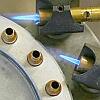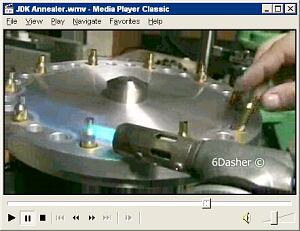Annealing–Restoring Life to your Brass
 When you look at a new piece of Lapua brass you’ll notice the neck and shoulder area is a darker color. That darker hue comes from the annealing process. You can do this yourself to extend the useful life of your brass. Click HERE to read our Annealing Guide and learn all about annealing methods. After many firings and reloading cycles, brass work-hardens, losing its resiliency or “springiness”. This will affect the consistency of neck tension, a very important factor in accuracy. By annealing your cases regularly you can extend their useful life. Champion 30BR shooter Joe Entrekin anneals his brass very often and his brass is still winning matches after 40+ firings. We normally recommend annealing when you notice the brass has stiffened signficantly, or after 7-8 firings. There are many different methods to anneal brass. You can anneal by hand, or use a machine. It’s a good idea to mark your necks with a temperature-sensitive laquer or Tempil stick so you don’t overheat the cases (which can ruin them). Unless you’re very skilled at manual annealing, the machines normally produce the most consistent results.
When you look at a new piece of Lapua brass you’ll notice the neck and shoulder area is a darker color. That darker hue comes from the annealing process. You can do this yourself to extend the useful life of your brass. Click HERE to read our Annealing Guide and learn all about annealing methods. After many firings and reloading cycles, brass work-hardens, losing its resiliency or “springiness”. This will affect the consistency of neck tension, a very important factor in accuracy. By annealing your cases regularly you can extend their useful life. Champion 30BR shooter Joe Entrekin anneals his brass very often and his brass is still winning matches after 40+ firings. We normally recommend annealing when you notice the brass has stiffened signficantly, or after 7-8 firings. There are many different methods to anneal brass. You can anneal by hand, or use a machine. It’s a good idea to mark your necks with a temperature-sensitive laquer or Tempil stick so you don’t overheat the cases (which can ruin them). Unless you’re very skilled at manual annealing, the machines normally produce the most consistent results.
Annealing Video with Home-Built Carousel
Our Dutch friend Jim DeKort created this 2.5 minute video of his annealing machine in action, processing 6BR cases. This carousel unit, similar to Ken Light’s BC 1000, was designed and built by Jim’s father. Currently Jim leaves a gap between each shell to allow more “flame time” per case. But with a second torch he can have a case in each slot. The cartridges spin in their mounting holes while they are rotated clockwise by the shell wheel. Right-Click on Screenshot and “Save As” to download 2.8 megabyte Windows Media video. If you have the video plug-in, you can left-click to watch the video.
Similar Posts:
- New Annealing Machines from Ballistics Edge Mfg.
- Bench-Source Annealing Machine — Video Review by 6.5 Guys
- The 6.5 Guys Review Bench-Source Annealing Machine
- New Brass Restoration Service Launched — Combined Ultrasonic Case Cleaning and Annealing
- Revive Your Brass with DJ’s Brass Service & Restoration



















Why do some say to quench and others, like y’all show no quench?
EDITOR: You should read the article on annealing: http://www.6mmbr.com/annealing.html
Quenching is a bit misunderstood. Yes it does serve to prevent overheating of the case–that’s a good thing. But it does not otherwise improve the annealing process or make for a better anneal of the neck area. One of the reasons a liquid quench is not needed with the machines like the Ken Light machine is than the big metal carousel serves as a heat sink and also shields the bottom of the case. Also the duration of the neck’s exposure to flame is carefully controlled. The neck area gets to the optimal temperature without overheating the bottom. At that point the case moves out of the flame and is allowed to cool naturally. There is no benefit of quick-cooling the case in water so long as it doesn’t get too hot.
People who anneal manually often prefer to quench their cases to prevent overheating. There is also a method of annealing cases that are standing in a shallow pan of water. Once the neck reaches the right temp, one tips over the case to cool it. Again, this is not a bad thing… but the quick cool does not improve the outcome for the annealed neck section of the case. A slow cool-down of the neck can achieve the desired results.
“Unlike steel, which will be made harder when it is cooled rapidly, brass is virtually unaffected when it is rapidly cooled. Annealing brass and suddenly quenching it in water will have no measurable effect on the brass. Cartridge cases are made of brass. When cartridge cases have been reloaded a number of times, the case necks become harder. Annealing will return the cartridge case necks to their factory original state.”
Are these machines for sale, and if so how do you get the info to buy one?